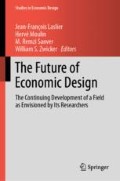Abstract
The stand alone core conditions have played a key role in the fair allocation literature for decades and has been successfully applied in many types of models where agents share a common cost or revenue. Yet, the stand-alone core conditions are not indispensable when looking for fair ways to share. The present note provides a few examples of network models where the relevance of the stand-alone core is questionable and fairness seems to require a different approach. In a networked future, design of allocation mechanisms is therefore likely to move beyond the stand alone core.
Access this chapter
Tax calculation will be finalised at checkout
Purchases are for personal use only
Notes
- 1.
In case of surplus sharing the stand-alone conditions become lower bounds: no coalition of agents should get less surplus than what they could obtain standing alone.
- 2.
See e.g., Peleg and Sudhölter (2007) for various properties of cooperative games as well as solution concepts.
- 3.
An allocation rule \(\phi \) satisfies cost additivity if, for any two cost vectors c and \(c'\), that \(\phi (c+c') = \phi (c) + \phi (c').\)
- 4.
Several algorithms exists for finding a max-flow in a given graph with given capacity constraints, see e.g., Kozen (1992).
- 5.
In the related context of network formation games, Jackson (2005) points at similar types of problems because a cooperative game cannot account for the fact that the same group of agents may connect in different network configurations, and these may have different value for the group.
References
Bergantinos, G., & Vidal-Puga, J. J. (2007). A fair rule in minimum cost spanning tree problems. Journal of Economic Theory, 137, 326–352.
Bird, C. G. (1976). On cost allocation for a spanning tree: A game theoretic approach. Networks, 6, 335–350.
Curiel, I. (1997). Cooperative game theory and applications: Cooperative games arising from combinatorial optimization problems. Kluwer Academic Publishers.
Ford, L. R., & Fulkerson, D. R. (1962). Flows in networks. Princeton University Press.
Granot, D., & Huberman, G. (1981). Minimum cost spanning tree games. Mathematical Programming, 21, 1–18.
Hougaard, J. L. (2009). An introduction to allocation rules. Springer.
Hougaard, J. L. (2018). Allocation in networks. MIT Press.
Hougaard, J. L., & Moulin, H. (2014). Sharing the cost of redundant items. Games and Economic Behavior, 87, 339–352.
Hougaard, J. L., & Moulin, H. (2018). Sharing the cost of risky projects. Economic Theory, 65, 663–679.
Jackson, M. O. (2005). Allocation rules for network games. Games and Economic Behavior, 51, 128–154.
Kalai, E., & Zemel, E. (1982a). Totally balanced games and games of flow. Mathematics of Operations Research, 7, 476–478.
Kalai, E., & Zemel, E. (1982b). Generalized network problems yielding totally balanced games. Operations Research, 30, 998–1008.
Kozen, D. C. (1992). The design and analysis of algorithms. Springer.
Littlechild and Thompson. (1977). Aircraft landing fees: A game theoretic approach. Bell Journal of Economics, 8, 186–204.
Megiddo, N. (1978). Cost allocation for Steiner trees. Networks, 8, 1–6.
Moulin, H. (1988). Axioms of cooperative decision making. Cambridge University Press.
Moulin, H. (2002). Axiomatic cost and surplus sharing: In Arrow et al. (Eds.), Handbook of social choice and welfare (pp. 289–357).
Moulin, H. (2013). Cost sharing in networks: Some open questions. International Game Theory Review, 15, 1340001.
Moulin, H., & Laigret, F. (2011). Equal-need sharing of a network under connectivity constraints. Games and Economic Behavior, 72, 314–320.
Peleg, B., & Sudhölter, P. (2007). Introduction to the theory of cooperative games (2nd ed.). Kluwer.
Quant, M., Borm, P., & Reijnierse, H. (2006). Congestion network problems and related games. European Journal of Operational Research, 172, 919–930.
Sharkey, W. W. (1995). Network models in economics. In Ball et al. (Eds.), Handbooks in operations research and management science (pp. 713–765).
Sun, X., & Fang, Q. (2007). Core stability and flow games. In J. Akiyama, et al. (Eds.), Discrete geometry, combinatorics and graph theory. Lecture notes in computer science. Springer.
Tamir, A. (1989). On the core of the traveling salesman cost allocation game. Operations Research Letters, 8, 31–34.
Tamir, A. (1991). On the core of network synthesis games. Mathematical Programming, 50, 123–135.
Young, H. P. (1994). Equity. Princeton University Press.
Acknowledgements
Constructive comments from Justin Leroux and Christian Trudeau are gratefully acknowledged.
Author information
Authors and Affiliations
Corresponding author
Editor information
Editors and Affiliations
Rights and permissions
Copyright information
© 2019 Springer Nature Switzerland AG
About this chapter
Cite this chapter
Hougaard, J.L. (2019). Beyond the Stand-Alone Core Conditions. In: Laslier, JF., Moulin, H., Sanver, M., Zwicker, W. (eds) The Future of Economic Design. Studies in Economic Design. Springer, Cham. https://doi.org/10.1007/978-3-030-18050-8_39
Download citation
DOI: https://doi.org/10.1007/978-3-030-18050-8_39
Published:
Publisher Name: Springer, Cham
Print ISBN: 978-3-030-18049-2
Online ISBN: 978-3-030-18050-8
eBook Packages: Economics and FinanceEconomics and Finance (R0)

